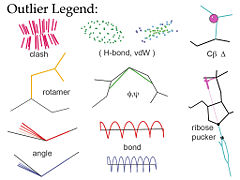MolProbity
From Proteopedia
(added image) |
(format, headings) |
||
| Line 1: | Line 1: | ||
| - | [[Image:MolProbity_Logo_610x300_Wbkg.jpg|thumb| | + | [[Image:MolProbity_Logo_610x300_Wbkg.jpg|thumb|left|120px|]] |
[[Image:Validation_outlier_legend.jpg|thumb|right|240px|Graphical validation icons in MolProbity]] | [[Image:Validation_outlier_legend.jpg|thumb|right|240px|Graphical validation icons in MolProbity]] | ||
| - | '''MolProbity'''<ref>doi:10.1093/nar/gkh398</ref><ref>doi:10.1093/nar/gkm216</ref><ref name="Chen2010">doi: 10.1107/ | + | '''MolProbity'''<ref>doi:10.1093/nar/gkh398</ref><ref>doi:10.1093/nar/gkm216</ref><ref name="Chen2010">doi: 10.1107/S0907444909042073</ref> is a web service for validation of 3D atomic models of macromolecules (protein, RNA, etc) produced by experimental methods such as x-ray crystallography or nuclear magnetic resonance (NMR). Its central feature is "all-atom contact analysis", which adds and optimizes all hydrogen atoms in the Reduce program<ref name="Reduce">doi:10.1006/jmbi.1998.2401</ref> and then calculates their H-bond, steric clash, and favorable van der Waals contacts in Probe<ref name="Probe">doi: 10.1006/jmbi.1998.2400</ref>. The contact analysis is both sensitive and powerful because the H's are about half the atoms in a protein and over 1/3 in nucleic acids, and they make most of the molecular contacts. Those local packing criteria are supplemented with updated versions of traditional validation criteria such as Ramachandran, rotamer, and covalent-geometry measures, and a few new criteria for RNA structure. MolProbity produces a variety of both global and local numerical scores, and visualizes the individual outliers on the 3D structure - a key to those outlier flags is shown in the figure. |
| + | |||
| + | ==All-Atom Contacts== | ||
| + | |||
| + | ==Conformational Criteria== | ||
| + | |||
| + | ===Ramachandran=== | ||
| + | |||
| + | ===Sidechain Rotamers=== | ||
| + | |||
| + | ===RNA Backbone Conformers & Ribose Puckers=== | ||
| + | |||
| + | ==Geometrical Criteria== | ||
| + | |||
| + | ===Bond Lengths & Angles=== | ||
| + | |||
| + | ===Cβ Deviations=== | ||
| + | |||
| + | ==MolProbity Score and Percentiles== | ||
| + | |||
| + | ==References== | ||
| + | <references/> | ||
Revision as of 16:29, 9 June 2012
MolProbity[1][2][3] is a web service for validation of 3D atomic models of macromolecules (protein, RNA, etc) produced by experimental methods such as x-ray crystallography or nuclear magnetic resonance (NMR). Its central feature is "all-atom contact analysis", which adds and optimizes all hydrogen atoms in the Reduce program[4] and then calculates their H-bond, steric clash, and favorable van der Waals contacts in Probe[5]. The contact analysis is both sensitive and powerful because the H's are about half the atoms in a protein and over 1/3 in nucleic acids, and they make most of the molecular contacts. Those local packing criteria are supplemented with updated versions of traditional validation criteria such as Ramachandran, rotamer, and covalent-geometry measures, and a few new criteria for RNA structure. MolProbity produces a variety of both global and local numerical scores, and visualizes the individual outliers on the 3D structure - a key to those outlier flags is shown in the figure.
Contents |
All-Atom Contacts
Conformational Criteria
Ramachandran
Sidechain Rotamers
RNA Backbone Conformers & Ribose Puckers
Geometrical Criteria
Bond Lengths & Angles
Cβ Deviations
MolProbity Score and Percentiles
References
- ↑ Davis IW, Murray LW, Richardson JS, Richardson DC. MOLPROBITY: structure validation and all-atom contact analysis for nucleic acids and their complexes. Nucleic Acids Res. 2004 Jul 1;32(Web Server issue):W615-9. PMID:15215462 doi:10.1093/nar/gkh398
- ↑ Davis IW, Leaver-Fay A, Chen VB, Block JN, Kapral GJ, Wang X, Murray LW, Arendall WB 3rd, Snoeyink J, Richardson JS, Richardson DC. MolProbity: all-atom contacts and structure validation for proteins and nucleic acids. Nucleic Acids Res. 2007 Jul;35(Web Server issue):W375-83. Epub 2007 Apr 22. PMID:17452350 doi:10.1093/nar/gkm216
- ↑ Chen VB, Arendall WB 3rd, Headd JJ, Keedy DA, Immormino RM, Kapral GJ, Murray LW, Richardson JS, Richardson DC. MolProbity: all-atom structure validation for macromolecular crystallography. Acta Crystallogr D Biol Crystallogr. 2010 Jan;66(Pt 1):12-21. Epub 2009 Dec 21. PMID:20057044 doi:10.1107/S0907444909042073
- ↑ Word JM, Lovell SC, Richardson JS, Richardson DC. Asparagine and glutamine: using hydrogen atom contacts in the choice of side-chain amide orientation. J Mol Biol. 1999 Jan 29;285(4):1735-47. PMID:9917408 doi:10.1006/jmbi.1998.2401
- ↑ Word JM, Lovell SC, LaBean TH, Taylor HC, Zalis ME, Presley BK, Richardson JS, Richardson DC. Visualizing and quantifying molecular goodness-of-fit: small-probe contact dots with explicit hydrogen atoms. J Mol Biol. 1999 Jan 29;285(4):1711-33. PMID:9917407 doi:10.1006/jmbi.1998.2400


